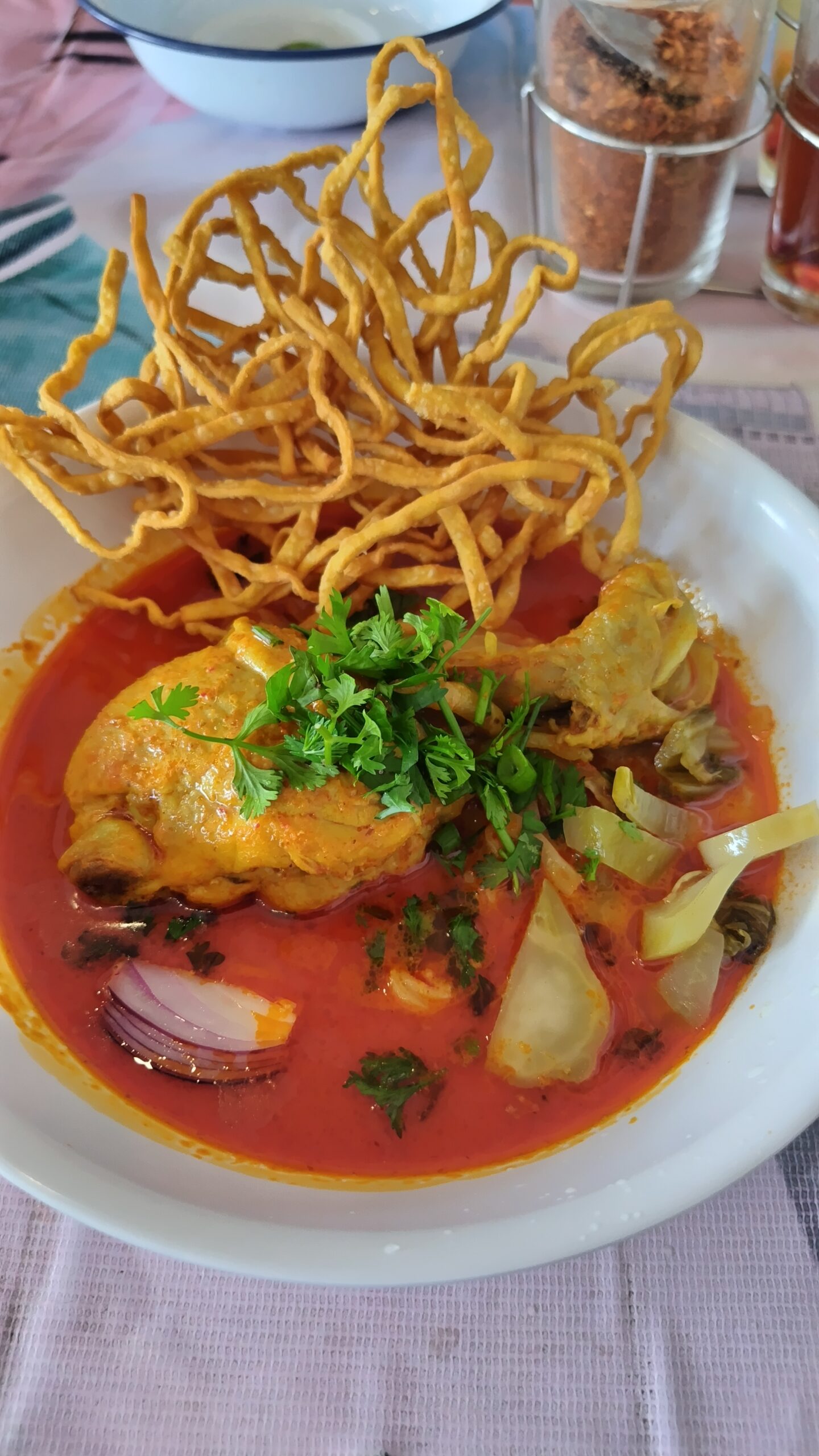The prices in this article are as of February 2024. 1 Thai Baht is calculated as approximately 4.2 JPY. When traveling to Thailand, enjoying Thai cuisine is a highlight. While many dishes can be found in Japan, some are truly unique to Thailand. I typically avoid tourist-oriented restaurants and high-end establishments, preferring to eat mostly at street food stalls. This article will introduce dishes I personally enjoyed in Bangkok and Chiang Mai.
Noodle Dishes
Sen Lek Nam (First, try ordering this!)
If you’re ordering a noodle dish from a Thai street stall for the first time, I recommend Sen Lek Nam. You’ll definitely find it at any noodle stall. Sen Lek Nam is a type of Thai-style noodle soup (Kuay Teow) with medium-thick rice noodles in a clear, mild, and flavorful broth. It’s subtle yet rich in umami, and I believe it suits Japanese palates. If you don’t like cilantro, just say “No cilantro,” and you’ll be fine.
When you order Thai-style noodles, they usually bring a set of condiments. You can add chili and vinegar to your liking, but I highly recommend trying sugar. You’ll notice the soup’s flavor deepening significantly with just one spoon of sugar. Give it a try!
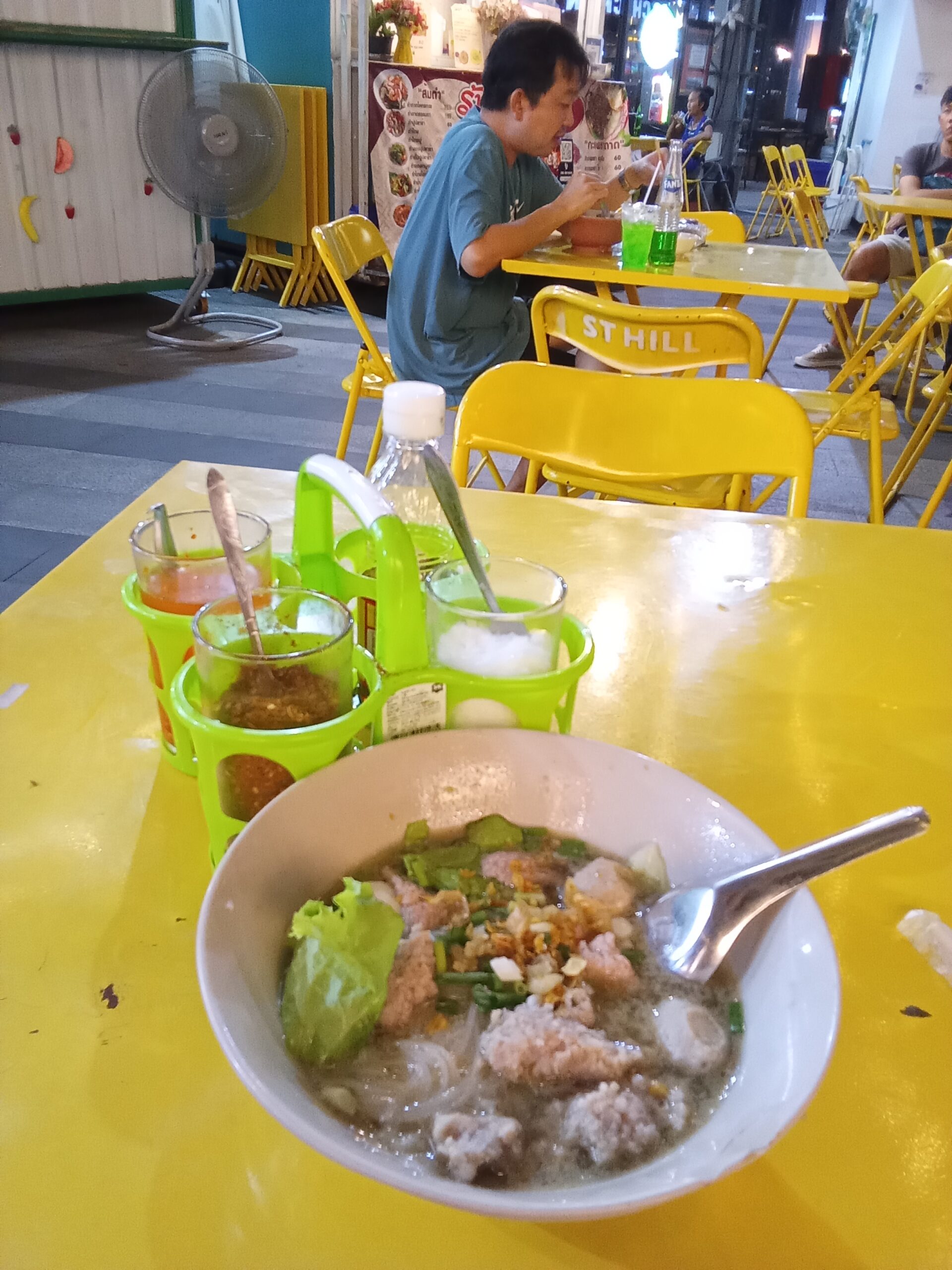
Ba Mee Tom Yum
If you enjoy Tom Yum soup, I recommend Ba Mee Tom Yum. This dish features yellow wheat noodles (Ba Mee) in a Tom Yum broth. It might not be for beginners, but it’s definitely worth trying. For Thai-style noodles (Kuay Teow), you can choose your noodle and soup combination, but I think Ba Mee noodles (Chinese wheat noodles) pair best with Tom Yum soup. I found this dish available in both Bangkok and Chiang Mai; if you see yellow noodles, be sure to ask for it.
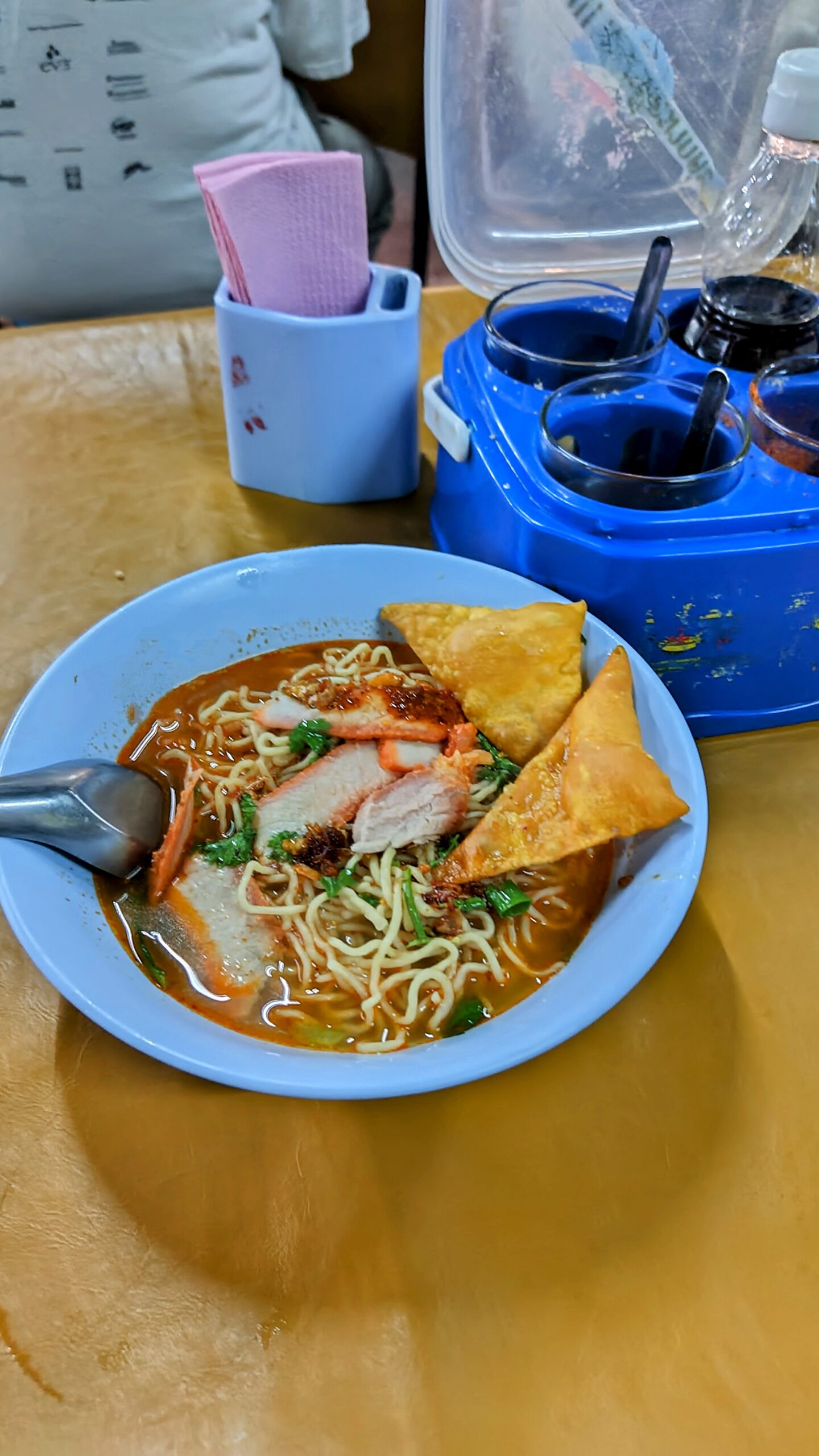
Khao Soi
Khao Soi is a famous dish from Chiang Mai, sometimes called Thai-style curry ramen. It’s characterized by a coconut milk-based curry-flavored soup topped with both boiled and fried noodles. The addition of raw shallots also seems to be a common feature. Khao Soi Gai (chicken Khao Soi) is probably the most popular. While I’m not entirely sure why fried noodles are included, the sweet coconut milk and curry flavor probably appeal to Japanese tastes. You can likely find it in Bangkok, but in Chiang Mai, the photo on the right shows it for 50 Baht (210 JPY). If you visit Northern Thailand, definitely give it a try.
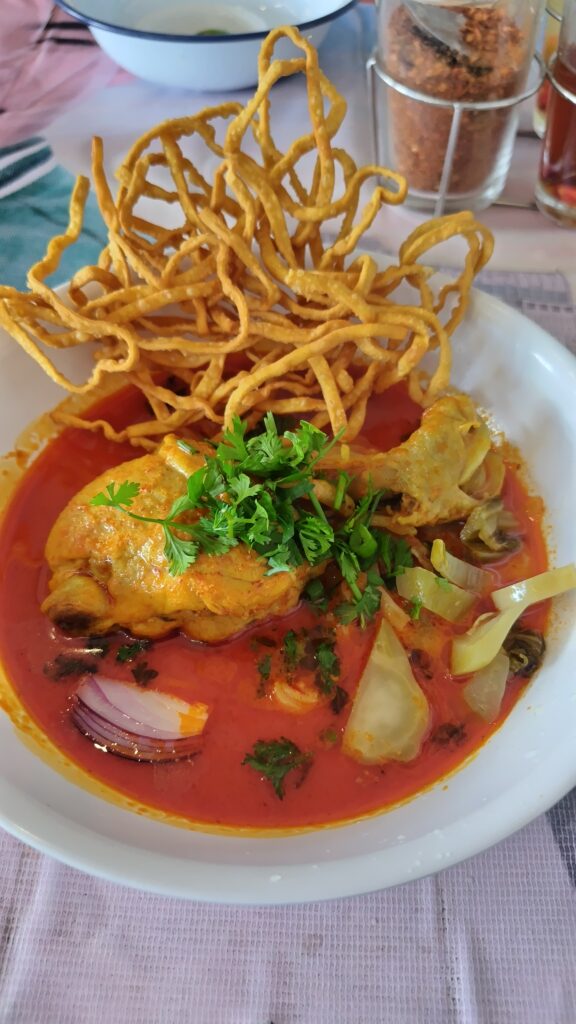
Rice Dishes
Point-and-Choose Side Dishes and White Rice at the Market
If you’re staying near a market, I recommend getting takeaway rice with side dishes from there. Various side dishes will be on display; just point to what you want and say “Ao An Ni” (I want this), and they’ll put it in a bag for you. If you add “Khao Plao,” they’ll include white rice. In Chiang Mai markets, side dishes are typically 40-50 Baht, and rice is 10 Baht.
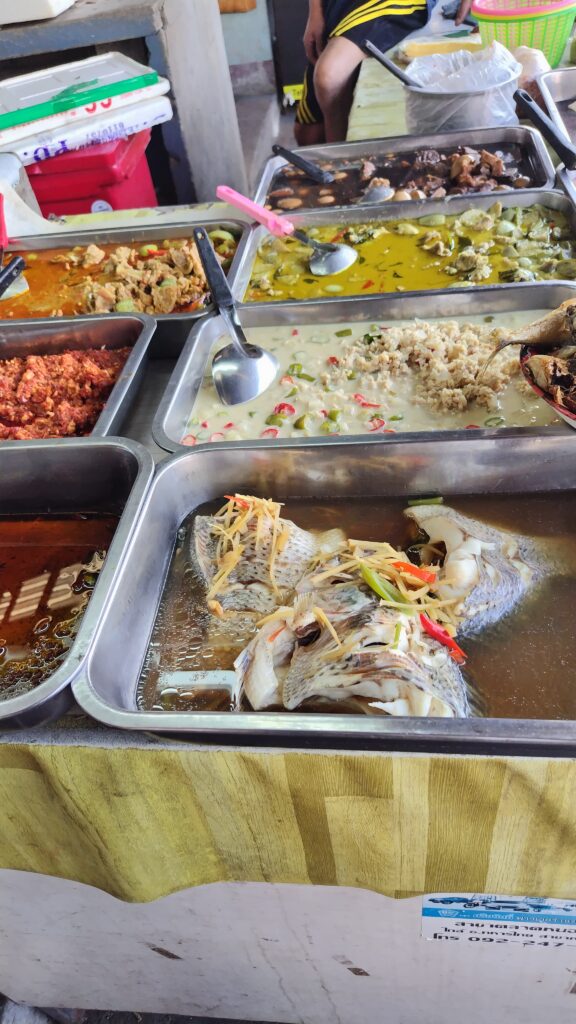
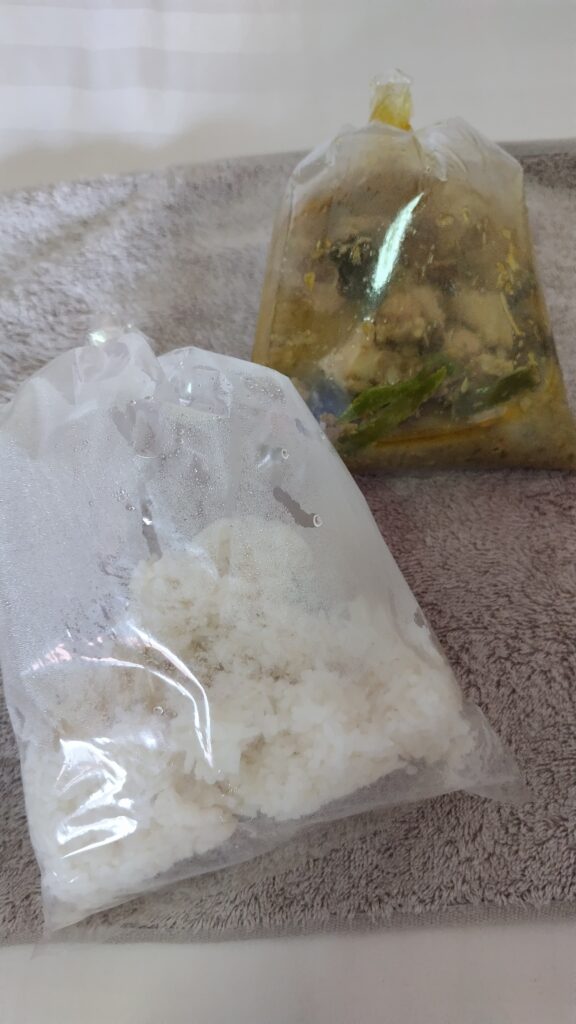
Chiang Mai Sausage and Sticky Rice
You’ll almost certainly find stalls selling sausages at markets. The picture on the right shows a spicy sausage, a specialty of Northern Thailand. It has a unique flavor, but I think it pairs well with beer. If you’re having it with rice, sticky rice (Khao Niao in Thai) goes particularly well with it. When buying, just point to the sausage and say “Ao An Ni, Khao Niao.” I personally like to add cilantro to this. The going rate is 15 Baht for a sausage and 10 Baht for sticky rice. If you visit Northern Thailand, definitely check out the markets.
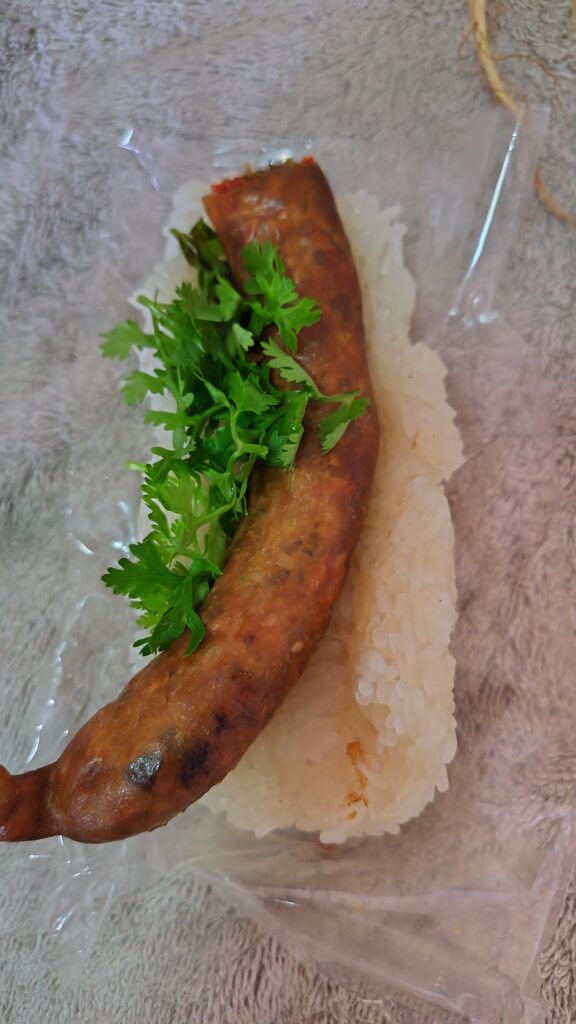
Khao Man Gai
Khao Man Gai is a famous dish in Japan too. It consists of boiled chicken served over rice cooked in chicken broth, eaten with a spicy sauce. Since neither the chicken nor the rice are heavily seasoned or oily, it’s a refreshing and easy-to-eat dish if you adjust the sauce. I think it’s perfect when you’re tired of other Thai dishes. At local shops in Chiang Mai, it’s typically around 50 Baht. While the taste of the chicken doesn’t vary much between shops, I’ve noticed differences in the flavor of the rice.
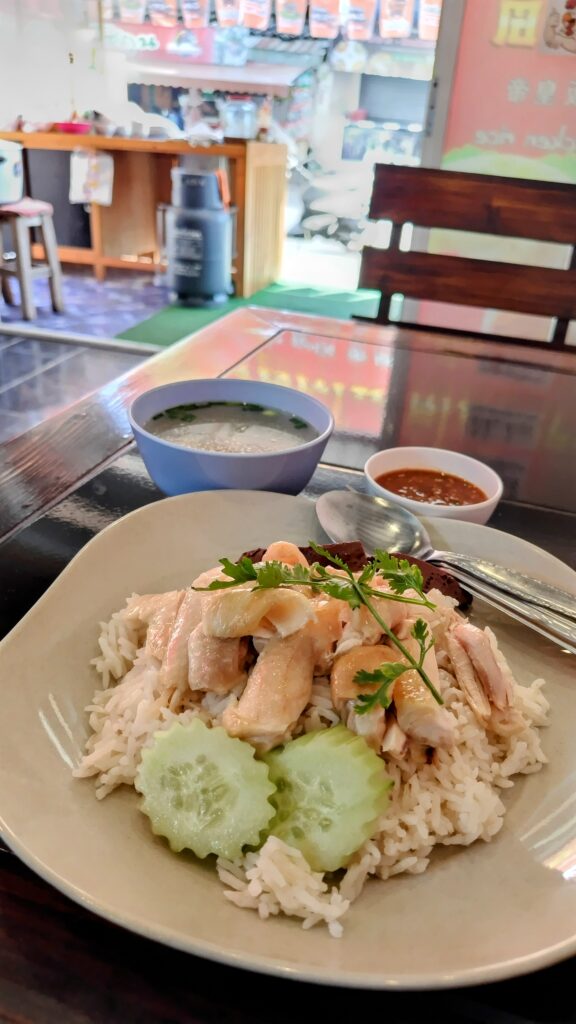
Khao Pad Goong / Khao Pad Moo (Shrimp Fried Rice / Pork Fried Rice)
This is essentially Chinese-style fried rice. “Khao” means rice, “Pad” means stir-fry, and “Goong” means shrimp. This is exactly what you’d expect from shrimp fried rice. Even if you’re not a fan of Thai food, this dish should be fine. In Chiang Mai, it’s typically 50 Baht, but shrimp fried rice specifically can sometimes be priced higher (60 Baht).
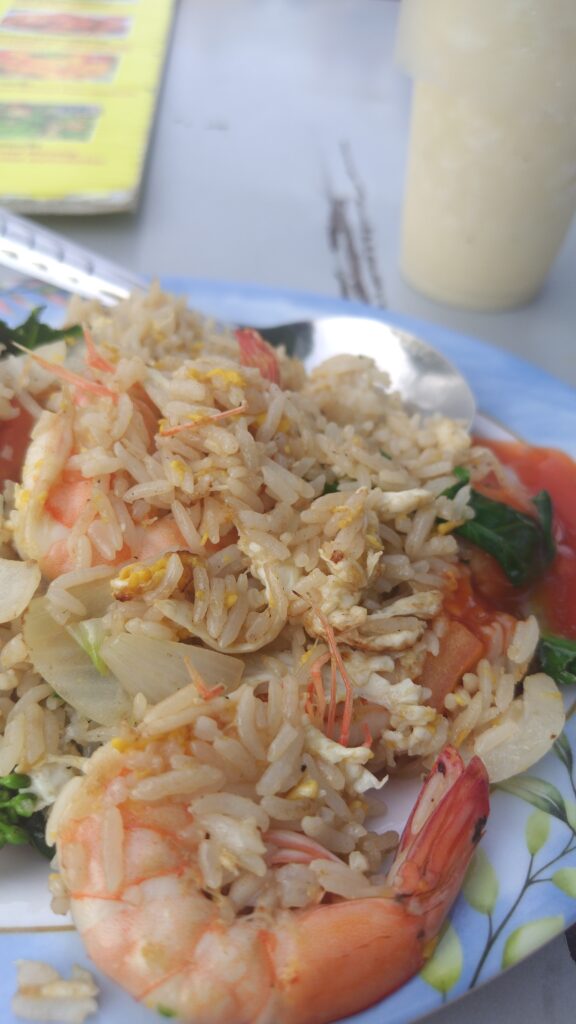
Khao Kha Moo (Stewed Pork Leg Rice)
Khao Kha Moo is a dish of tenderly stewed pork leg served over rice. The menu often lists it with its Chinese characters, 猪脚饭. The seasoning feels similar to Taiwanese Lu Rou Fan. While you can find it at street stalls, it’s more commonly served at roadside eateries specializing in Chinese-style menus. In Chiang Mai street stalls, it was 50 Baht. It would likely be slightly more expensive at roadside restaurants.
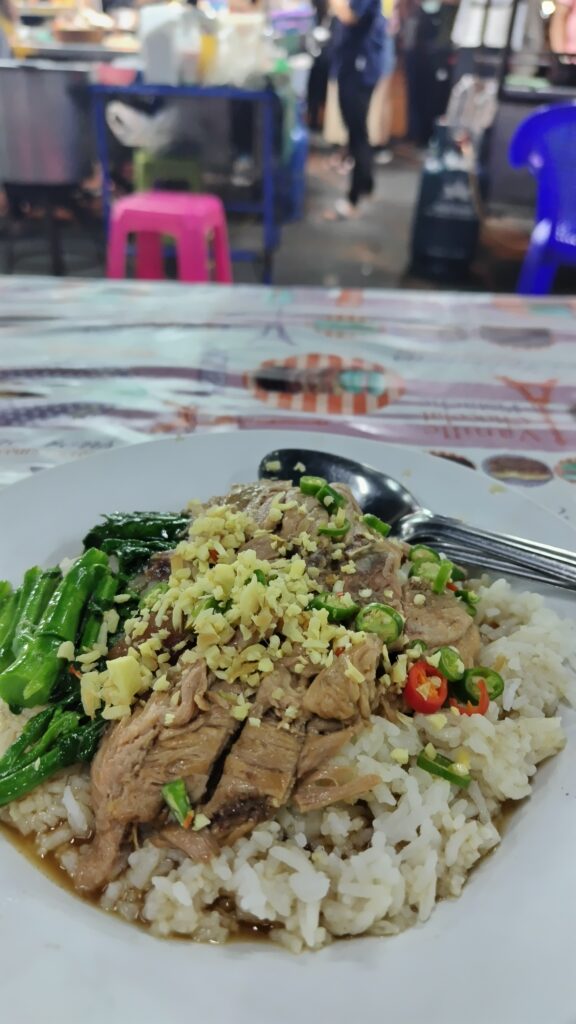
Jok (Porridge)
Jok is a menu item served at porridge stalls that are only open in the mornings. They typically close around 9 or 10 AM. The Jok in the picture on the right is what would be called porridge in Japan, where the rice grains are cooked down until almost dissolved. This dish, like other porridges in Southeast Asia, differs from Japanese porridge in that it’s more richly flavored and something you’d want to eat even when feeling energetic. The price is around 40 Baht.
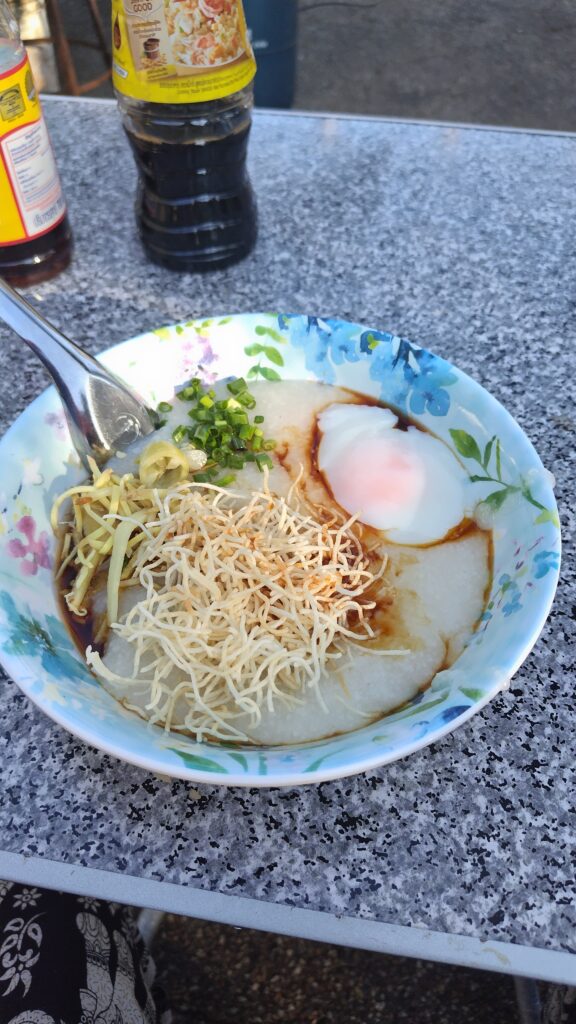
Khao Tom (Rice Soup)
Khao Tom is another menu item served at the same porridge stalls as Jok. If Jok is porridge, then Khao Tom is more akin to a rice soup. The rice grains remain distinct in this version. While similar, the seasoning and ingredients differ. Personally, I preferred the taste of Khao Tom.
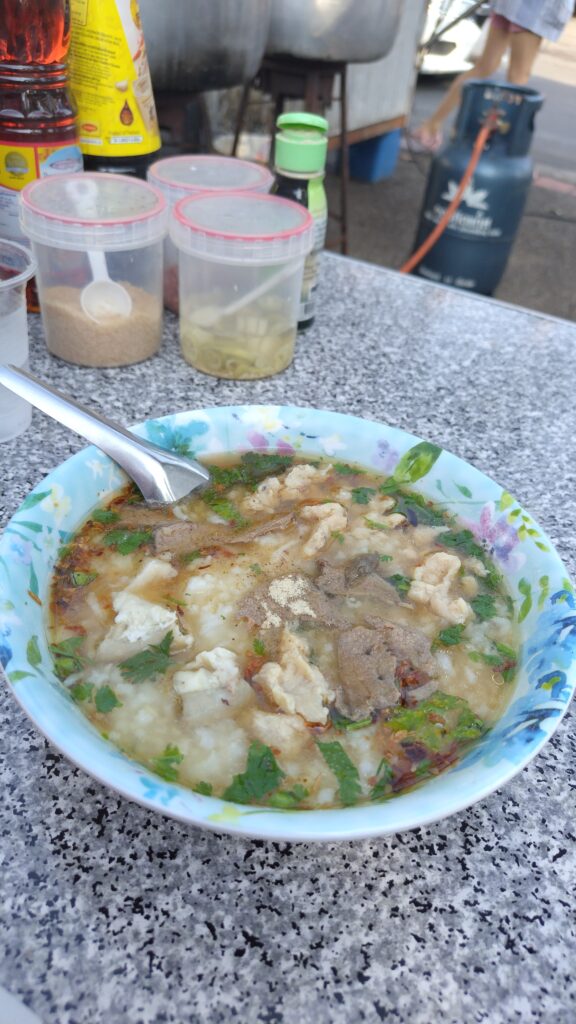
Kai Jeow (Omelet Rice)
Kai Jeow is a simple dish of omelet served over rice. It’s sold as a bento (lunchbox) at takeaway stalls or market deli sections. The price varies by the number of eggs; at stalls, it was 20 Baht for one egg and 30 Baht for two. Market bentos are priced similarly. However, freshly made Kai Jeow from a takeaway stall is, of course, far more delicious than a cold bento.
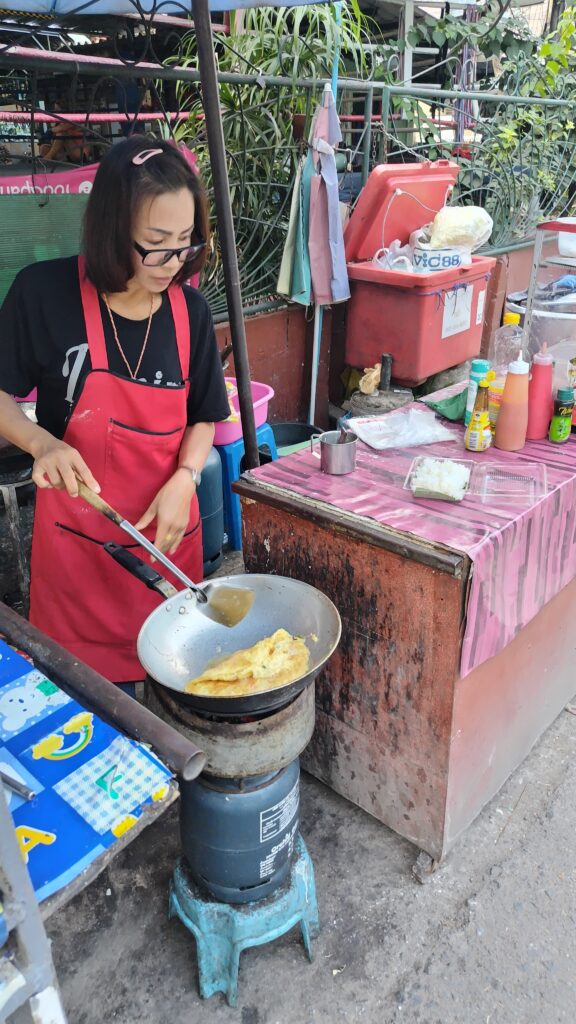
Others (Drinks, Desserts, Snacks)
Fruit Shake
Fruit shakes are available in many countries these days, but the prices at the night market stalls in Chiang Mai were unbelievably low. A single fruit shake was 20 Baht, and a two-fruit shake was 30 Baht. Being able to drink a shake for 84 JPY is something you won’t find in other countries. After Thailand, shakes felt expensive in every other country I visited! There are many kinds of fruits available, but my favorite is a single-banana shake.
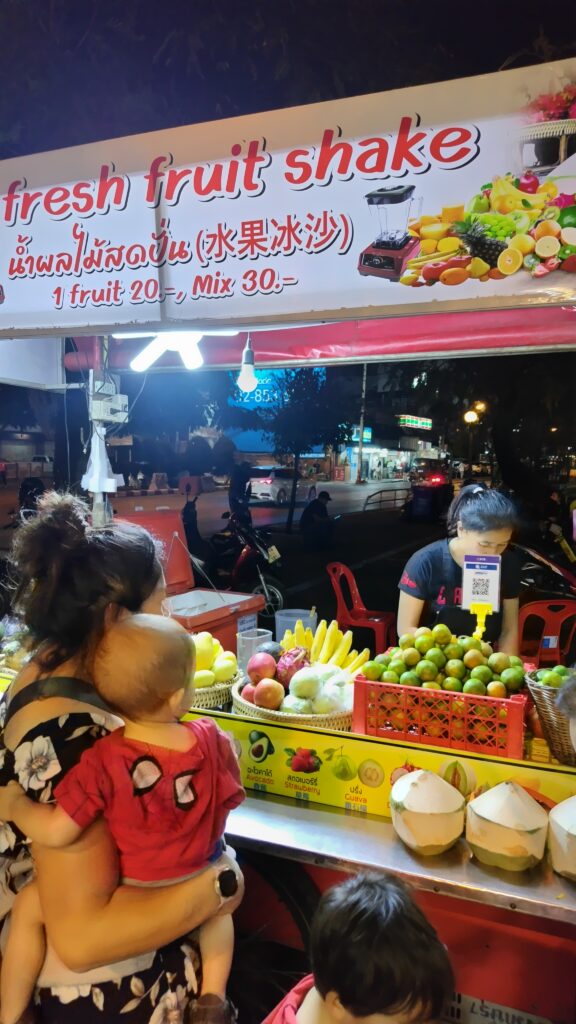
Pa Thong Ko (Fried Dough)
Pa Thong Ko is similar to Chinese Youtiao (fried dough sticks), but smaller and shorter. In Chinese cuisine, they are often eaten plain or dipped in porridge, but in Thailand, they are consumed as a dessert. I personally like them plain, with their subtle saltiness, but in Thailand, it’s common to eat them with a sweet green sauce, like the one shown in the upper right of the picture. At Chiang Mai stalls, they were 5 Baht each.
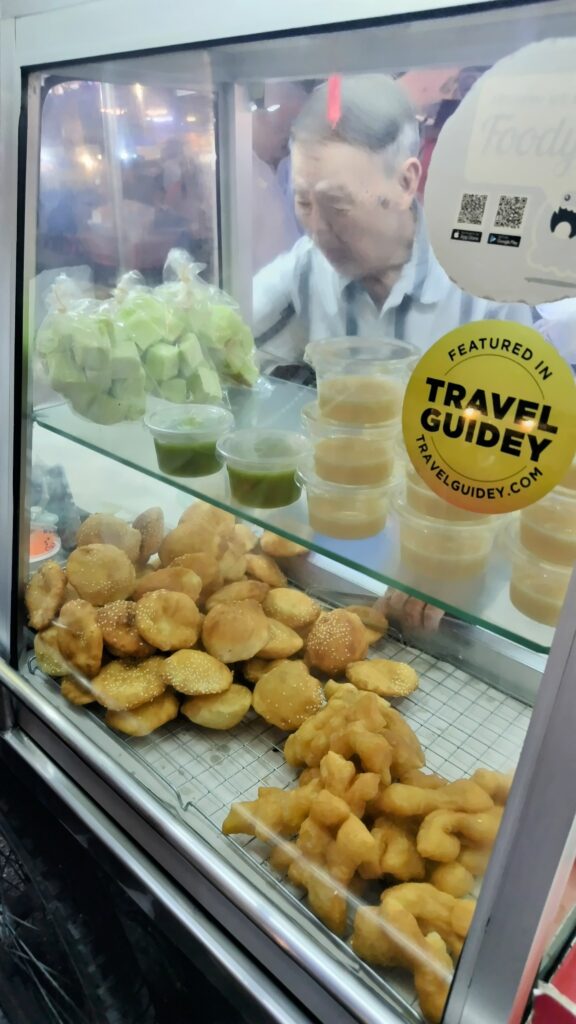
Roti
Roti is a sweet dessert made by frying a thin, crepe-like dough in oil, topping it with fruits, and drizzling condensed milk over it. At Chiang Mai stalls, it’s around 30 Baht. It’s best enjoyed fresh off the griddle.
Conclusion
How about that? Thailand has many more delicious dishes to offer. I highly recommend visiting Thailand and trying them yourself. The prices in this article are for street food stalls in the provincial city of Chiang Mai, so expect them to be higher in Bangkok or at roadside restaurants. These are presented as examples.

